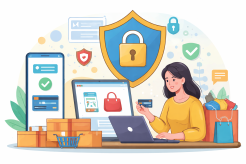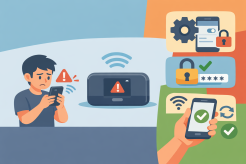What is Email Phishing Scam and How to Avoid them
There have been many individuals using this new convenience as a way to trick people and access their finances since the advent of the internet. Communication environments are made easier by emails, online shopping, and banking. But, you can be made weak by it. Phishing is an email sent to people who make false statements with the intention of attracting people to reveal sensitive data. It may be difficult to classify these addresses. We know the meaning of security and wanted to give you the best tips and advice.
What is Cyber Phishing?
Cyber phishing in an email masquerading as an online scam. Individuals that write these messages are searching for ways to access confidential data such as social security numbers, bank account information, or credit card details. The data is then used under your name to withdraw cash or to open a line of credit. Other versions of scams are usually finished as a telephone call or text message. Phishing directly refers to emails.
Cyber email phishing is a felony and it was back in 2004 that the first case took place. A teenager managed to create a fake website that replicated "America Online" and took confidential details from individuals successfully and managed to access and withdraw money from their credit cards.
Common Features of Emails Phishing
Among phishing emails, there are a few different characteristics that are common. Recognizing them will help safeguard you.
The offer is too good to be true
You can conclude that it's a scam in almost any case where the deal is eye-catching and very generous. When you have not entered a contest, a common example would be winning a prize such as a smartphone or cash.
Requires a response immediately
Of all the scams, perhaps the most famous is this one. Emails declaring that you have to respond immediately unless you want your account to be suspended are a scam. Reputable establishments can often give enough time to update details to their online customers. The sense of urgency can also apply to "deals." The data will usually say, "act now that you're going to miss out on this great deal," but then give you only minutes to claim the bid.
Hyperlinks Misspelled
Hyperlinks will be used in some emails. The URL details will appear when you hover over the hyperlink. Scammers will also use a common website with a slight misspelling that can be difficult to catch.
Attachments
Unrecognizable attachments are how your machine gets a virus from scammers.
Sent from a user that is not known
This choice is uncommon but can occur. The names of companies or friends you know are used by scammers to get you to open their emails. Typically, the suspicious title would give it away.
Also Read : Here's How to Protect Your Mac From Ransomware
Also, Read: Step by Step Guide on How to Fix AT&T Email Login Issues
How to Avoid Phishing Scams
Knowing the methods is only the start. Such emails can take different forms and look legitimate. Here are some tips about how an online scam can keep you from falling victim.
1. Don't click all the links
Do not click on them if you've opened an email from someone who looks suspicious and there are hyperlinks. They can plant or embed programs that enable access to your computer once you do so.
Check to see whether they are using your name if the email is sent from a bank or organization that you use. The first identification is generally that it's a scam to see "dear customer."
In addition, most banks or organizations would not ask you to fill out the details online. Call the company listed in the email if you are not sure of its legitimacy. DO NOT use any given number. Instead, to find the customer service number and inquire if this information is correct, do a separate search.
2. Update the browser
Organizations such as Apple, Microsoft, and Google are aware of phishing scams and are committed to keeping their customers secure. To prevent your information from being stolen, these and other major firms update their browsers with the latest technology. In order to be safe, check monthly for updates.
3. Have firewalls installed
To shield your computer from outside intruders, a firewall is a preventive measure. You should have installed two of them: a laptop and a network firewall. When used together, the risks of infiltration can be substantially lowered.
4. Don't believe in pop-ups
Suspicious websites can use pop-ups as a way to get you to remotely access your computer to download the tools they need. Be careful when you see a pop-up. Be careful when closing it down if it doesn't look legit. They will often cover the "X" in the hope that you would inadvertently click on the window/link.
5. Install Anti-Virus Applications
For those who want to add an additional layer of security against intruders, anti-virus software is excellent. The technology protects against viruses being downloaded to the device. Before being downloaded through the internet, the program will search every file. Daily updates include getting the best out of this program.
Related Articles:
Always Check the Website You Visit
Safe Internet: Tips to Stay Safe Online
Related Posts

Sat, Jan 3, 2026 12:06 AM
SafetyOnline Shopping Safety Guide: How to Shop Smart and Stay Secure
Learn how to shop safely online by avoiding scams, protecting personal data, securing payments, and building smart long-term shopping habits.

Fri, Jan 2, 2026 11:45 PM
mobile phone plansHow to Fix “Authentication Error” on a Mobile Hotspot
Learn how to fix the “Authentication Error” on a mobile hotspot with step-by-step troubleshooting tips to restore your internet connection quickly and reliably.

Thu, Jan 1, 2026 11:49 PM
cheap internet dealsWhat Counts as Fast Mobile Internet?
Discover what truly counts as fast mobile internet, how speeds are measured, and tips to optimize your mobile connectivity for streaming, browsing, and gaming.

Thu, Jan 1, 2026 2:30 AM
cheap internet offersBest Budget-Friendly Internet Providers in New York
Finding affordable internet in New York can feel like searching for a needle in a haystack. With so many options and fluctuating prices, it’s tough to know where to start—especially if you’re a student, freelancer, small business owner, or just someone trying to stretch every dollar. But don’t worry—we’ve done the digging for you.

Tue, Dec 30, 2025 10:21 PM
SafetyIs Your Phone Watching You? Real Signs and How to Lock It Down
Learn the real signs your phone may be spying on you, why it happens, and how to protect your privacy with practical, easy steps.
